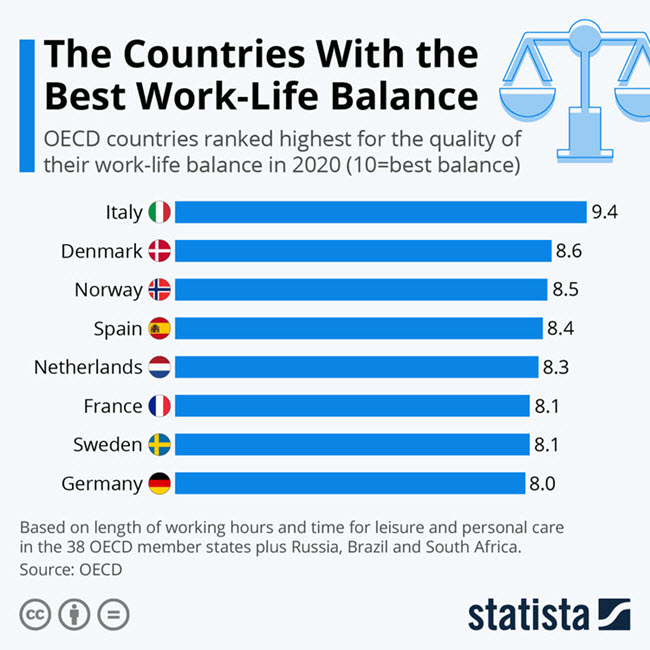

Work-life balance: current trends and characteristics
The balance between work life and personal life has become a hot topic in today's demanding and ever-changing work environments. Achieving a healthy balance between professional responsibilities and personal life has become a priority for both individuals and organizations. Work-life balance, also known as the balance between work life and personal life, refers to a state in which individuals effectively reconcile their professional responsibilities with their personal commitments. This involves finding a middle ground between work requirements, such as work schedules, professional responsibilities, and employer expectations, and personal needs, such as family time, leisure activities, rest, and mental and physical well-being.
Work-life balance worldwide
According to recent findings from the Organisation for Economic Co-operation and Development (OECD), European countries stand out particularly in terms of work-life balance. Italy, Denmark, and Norway lead this ranking, based on various indicators, while France ranks sixth and Germany ranks ninth among forty nations.
It is unsurprising that the key elements of a good life balance include time spent working and time allocated to leisure and family. Researchers emphasize that excessive working hours can have adverse effects on health, compromise safety, and increase stress.
According to the survey, Italians enjoy more free time for personal activities and leisure. Only 3% of Italian workers have very long working weeks, including 50 hours or more. In comparison, nearly 8% of French workers work as many hours or more each week. This percentage rises to over 10% for American workers, contributing to placing the United States among the countries with the least satisfactory work-life balance.

Statista infographic: The countries with the best work-life balance1
Characteristics of work-life balance
When we address the issue of work-life balance, four fundamental concepts emerge: time allocation, flexibility, integration, and well-being.
Characteristics of work-life balance
Time allocation
Work-life balance is distinguished by effective management of time and energy, where each sphere of existence receives appropriate attention. This involves clearly delineating moments dedicated to work from periods reserved for personal activities, such as family time, leisure, personal care, and social interactions. This balanced distribution promotes the overall well-being of the individual by ensuring that no aspect of life is neglected to the detriment of others.
Flexibility
Flexibility plays an essential role in achieving work-life balance. It allows individuals to take control of their schedules and adapt them to their personal needs and priorities. This flexibility can take various forms, such as flexible working hours, telecommuting arrangements, compressed workweeks, or job sharing. By offering workers the opportunity to reconcile their professional commitments with their personal obligations, flexibility promotes a better quality of life and greater job satisfaction.
Integration
Unlike the traditional notion that strictly separates work and personal life, work-life balance favors their harmonious integration. This approach recognizes that personal and professional well-being are closely linked and can mutually reinforce each other. Instead of considering them as separate entities, integration aims to find synergies between the two spheres and align professional goals with personal values. This holistic approach promotes overall individual fulfillment, both personally and professionally.
Well-being
At the heart of work-life balance lies the priority given to individual well-being. This encompasses the physical, mental, and emotional health of the individual. Striving for balance involves taking care of oneself, managing stress, and finding ways to relax and recharge outside the professional context. By focusing on well-being, work-life balance promotes better overall health, greater resilience to stress, and increased satisfaction in all areas of life.
Recommended articles:
Trends in work-life balance
Trends in work-life balance have evolved over time in response to societal, technological, and organizational changes. In the past, the traditional work model often involved fixed schedules and a clear separation between work and personal life. However, with the advent of mobile communication technologies and remote work, the boundaries between work and personal life have become increasingly blurred. More and more companies are adopting flexible work policies, such as telecommuting and flexible hours, to enable their employees to better reconcile their professional obligations with their personal lives.
Remote work and flexible work
The COVID-19 pandemic has accelerated the adoption of remote work and flexible work arrangements. This trend allows individuals to have more control over their work schedules and eliminates commuting time, resulting in greater flexibility and a better balance between work and personal life.
Technology and connectivity
Advancements in technology have enabled constant connectivity, blurring the boundaries between work and personal life. While technology brings convenience and flexibility, it also poses challenges in maintaining work-life balance. The trend now is towards setting digital boundaries and promoting mindful use of technology.
Emphasis on employee well-being
Organizations recognize the importance of employee well-being as a strategic priority. Companies are implementing policies and initiatives that prioritize mental health, work-life balance, and overall employee well-being. This trend includes wellness programs, mental health support, and initiatives aimed at promoting the integration of work and personal life.
Organizational culture change
A positive organizational culture that values work-life balance is gaining importance. Companies are adopting a culture of flexibility, trust, and support, encouraging employees to achieve a balance between work and personal life without fear of negative consequences. This cultural shift promotes employee engagement, satisfaction, and retention.
Focus on boundaries and time management
With increasing demands and blurred boundaries, effective time management has become crucial. Time management techniques, such as setting priorities, delegating tasks, and establishing boundaries, help individuals maintain a healthy balance between work and personal life.
Focus on results and production
Organizations are shifting their focus from measuring work hours to evaluating results and outputs. This trend promotes a results-oriented approach that values productivity, efficiency, and the quality of work rather than the number of hours worked. By evaluating results rather than time spent, individuals can have more flexibility in managing their work and personal lives.
Work-life balance is a complex concept that underscores the need to find harmony between professional responsibilities and personal life. Characteristics such as time allocation, flexibility, integration, and well-being are key elements in achieving work-life balance.
Current trends in work-life balance underscore the importance of remote work, technology management, employee well-being, organizational culture, boundaries, time management, and results-oriented evaluation. By recognizing the importance of work-life balance and embracing these trends, individuals and organizations can create a more harmonious and fulfilling approach to work and personal life, leading to overall improvement in well-being and satisfaction.
1. Statista infographic: The countries with the best work-life balance